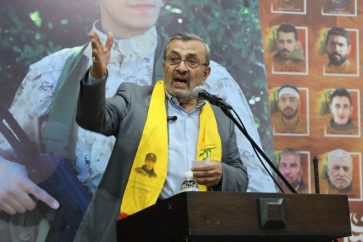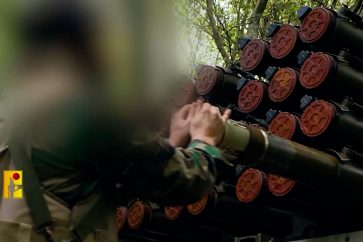“This resistance is our source of pride. It taught us everything. The resistance taught us that we can make strength out of our weakness,” said Sayyed Abbas Al-Mousawi, former Hezbollah Secretary General who was assassinated by Israeli occupation on February 16, 1992.
Sayyed Abbas was known for his resistance movement that knew no boundaries. Starting by Lebanon and Palestine, and not ending by Syria, Iraq, Iran, Pakistan and Afghanistan, Sayyed Abbas considered Palestine as the primary cause of the Muslim nation. He saw the resistance as a transnational movement that can’t only operate in one battlefield.
Palestine Was the Spark
 Inspired by a youth who was the first Lebanese to be martyred in a battle with Israeli occupation in 1968 in Jordan, Sayyed Abbas, who was 15 years old back then, went to Syria’s Zabadani to take part in a training camp established by Fatah Palestinian resistance movement.
Inspired by a youth who was the first Lebanese to be martyred in a battle with Israeli occupation in 1968 in Jordan, Sayyed Abbas, who was 15 years old back then, went to Syria’s Zabadani to take part in a training camp established by Fatah Palestinian resistance movement.
The senior commander then decided to apply himself to Hawza studies. He affiliated with leading Lebanese Shia cleric Imam Sayyed Mousa Al-Sadr in the southern town of Tyre. After that, he joined Hawza of Grand Ayatollah Sayyed Mohammad Baqer Al-Sadr in the holy city of Najaf. Sayyed Mohammad Baqer Al-Sadr was an influential Shia cleric, philosopher, political leader, and founder of the Daawa Party of Iraq.
Upon his arrival to Lebanon in 1978, when the Baathist regime expelled all non Iraqi clerics, Sayyed Abbas founded Al-Muntathar Hawza in Baalbeck. He believed that the role of this Hawza was not limited to the Shiite arena in Lebanon. In March 1978, the Israeli enemy launched an aggression on Lebanon in which it managed to occupy areas located to the south of Litani River. At time, Sayyed Abbas played pivotal role in mobilizing the Lebanese people for resistance.
Sayyed Abbas was highly inspired by the victory of the Islamic Revolution led by Imam Sayyed Ruhollah Khomeini in 1979. The revolution in Iran represented for the former Hezbollah S.G. a glimpse of hope in face of the US hegemony and Israeli oppression.
Establishing Hezbollah
Following the Israeli occupation of south Lebanon in June 1982, Sayyed Abbas returned to Lebanon from Tehran along with Sheikh Ragheb Harb, Lebanese cleric who was well-known for his anti-Israel stances and then was a senior Hezbollah commander. The two men worked at the end of that year on establishing the resistance movement, Hezbollah.
“The Islamic Resistance in south Lebanon. We called it Islamic because its ideology ad spirit is Islam. However, it is for all the oppressed people across the world,” Sayyed Abbas said about Hezbollah, the Islamic Resistance in Lebanon.
In that year (1982), Sayyed Abbas headed a delegation representing Hezbollah to Iran, where they met Imam Khomeini who blessed their efforts, telling them that “he sees victory on their foreheads,” according to “Jihad and Martyrdom Leader” documentary which explores the life of Sayyed Abbas.
Sacred Defense in Ahvaz
Later in 1983, Sayyed Abbad headed for Iran’s Ahvaz to take part in the sacred defense during the war launched by the Baathist regime in Iraq. Imam Khomeini dispatched his personal delegate Sheikh Abbas Al-Kaabi who urged Sayyed Abbas to go back to Lebanon, stressing that the Lebanese battlefield needed him more.
When he returned to Lebanon, Sayyed Abbas tried to strengthen ties with other Muslim clerics from outside the Shiite arena in a bid to boost Islamic unity and unify resistance movements allover Lebanon. He coordinated resistance efforts with both Sheikh Said Shaaban in the northern city of Tripoli and Sheikh Maher Hammoud in the southern city of Sidon.
Resistance Path of Victory
 “Sayyed Abbas presented the resistance as a path of victory not only as a path of martyrdom,” Hezbollah Secretary General Sayyed Hasan Nasrallah described his predecessor in the documentary which was aired on Al-Manar TV.
“Sayyed Abbas presented the resistance as a path of victory not only as a path of martyrdom,” Hezbollah Secretary General Sayyed Hasan Nasrallah described his predecessor in the documentary which was aired on Al-Manar TV.
Sayyed Abbas was the military commander of the Islamic Resistance in south Lebanon. He personally oversaw resistance operations which forced the Israeli enemy to withdraw from Beirut and then from Sidon to the southern villages and towns.
Visits to Pakistan, Afghanistan, Kashmir
In March 1990, Sayyed Abbas went to Pakistan, to take part in a pro-Palestine conference. In that visit he toured 17 Pakistani villages, where he tackled Israeli oppression, importance of resistance and US schemes in the region. After that, Sayyed Abbas visited Afghanistan, where he met with fighters against Soviet troops, and then he went to Kashmir.
Hezbollah S.G.
In April 1991, and following years of hard work in ranks of the Islamic Resistance, Sayyed Abbas was elected to be Hezbollah Secretary General. Sayyed Nasrallah narrates in the “Jihad and Martyrdom” documentary how long it took to convince Sayyed Abbas that he has to accept this post.
“After ten days of attempts to convince him, Sayyed Abbas accepted to assume his duties as the Secretary General of Hezbollah,” according to Sayyed Nasrallah.
Upon his election, Sayyed Abbas was maintained strong relation with resistance fighters as well as with Lebanese people whom was keen to serve them. He raised the slogan of “We Are All at Your Service,” referring to securing basic needs of the people in light of the state’s absence in several areas especially in south, Bekaa and Beirut southern suburb.
Martyrdom and Will
Sayyed Abbas was assassinated in February 16 1992, when he was returning from south Lebanon where there was a ceremony marking the martyrdom anniversary of Sheikh Ragheb Harb. Israeli Apache helicopters fired missiles at his motorcade, killing him, his wife, his five-year-old son, and four others.
Following his martyrdom, Sayyed Hasan Nasrallah succeeded Sayyed Abbas, whose primary will was to “preserve the Islamic Resistance.”
Source: Al-Manar Website




